In the second part of our sector spotlight, we review the impacts of Covid-19, the power of harnessing cost-effective building safety compliance and how we can build a safer future.

“While Covid-19 has been incredibly brutal, deadly and disruptive,” says consulting engineer Paul Condron, “we will emerge at the end, pick up the pieces and revert to normality. In my opinion, we must have this as a mind-set. Also, we must endeavour to return to safe and functional facilities. We can only achieve this by maintaining and servicing our life safety systems.”
As populations struggle to deal with the impacts of the virus, a sound philosophy is now more critical than ever for risk mitigation and safety.
“The duty-holders still retain their obligations in respect of their duty-of-care under health and safety regulations and other legislation,” adds Condron. “This virus does not change or reduce these duties or obligations.”
“The present conditions will make full adherence to requirements more difficult, and perhaps require risk assessment and specific engineered solutions in respect of the ability to comply with the intent of some required procedures or actions. In this Covid era, people may see an opportunity to make amendments to systems already in place. If a building is now empty, why not try and do something with it now?”
“The duty-holders still retain their obligations in respect of their duty-of-care under health and safety regulations and other legislation, this virus does not change or reduce these duties or obligations.”
Paul Condron, PCCE Consulting
As Head of Service Transformation and Innovation at Vivid, Justin Crittall and his colleagues are working hard to continue to deliver services with new safety measures in place.
There are significant implications for the provider of affordable homes and housing-related services, according to Crittall. “Our customers have been impacted in their ability to pay rent and maintain their houses,” he says. “It’s about considering how much investment we are doing in supporting our customers who are negatively affected.
“For us, it’s all about growth and how to tackle the housing shortage and develop future homes for future generations. However, we feel quite lucky in the sense that our core purpose is having houses and occupants paying rent, so, in theory, that doesn’t change in the Covid era.”
Crittall sees an opportunity for working practices to be reshaped as businesses continue to adjust to demands resulting from the pandemic. “Social distancing and the pandemic has meant that we cannot provide a service as normal anymore, which fundamentally affects our bottom-line,” “he explains. “We had to be agile and challenge ourselves around what face-to-face meetings really needed to exist. For example, we are now doing virtual viewings of properties. No longer are we meeting someone at a property and walking them around. They can download it all and view a property 24/7 from the comfort of their home.”
“What Covid-19 has done is made us think about practices without a physical human being present.”
Justin Crittall, Head of Service Transformation and Innovation, VIVID Homes
The accomplished professional with a history of working in the not-for-profit sector also believes there is further scope around virtual and augmented reality to enhance the user experience, for the benefit of both user safety and experience. ”Augmented reality could start to really immerse people into a 3D world when viewing a property. We’re also looking at how we can do more remote repairs and fixings. Rather than sending an engineer out, could we use video to have an engineer on the end of the line? In a video chat, you’d be able to talk someone through that and guide them through the process.”
By businesses going back to the traditional way, they are really restricting access, according to Crittall. “Looking at the customer experience, I think it’s a question of, ‘Why do we have some of these rigid approaches? What Covid-19 has done is made us think about practices without a physical human being present. Could our best technical qualified engineers be based in a contact centre environment instead? We’ve already started that pre-Covid around compliance checks, but it’s probably better to use technology to do that because it’s live and in real-time, and it’s also better in regards to data collection, retention and auditing.”
Technological advancements

As the world becomes a more digital and automated place, emerging technologies continue to shape industry standards. And, like other sectors, the building safety industry is under pressure to keep up.
Safecility CEO Cian O’Flaherty fundamentally believes that those responsible for buildings are going to be asked for more information and at a higher quality in the future, and the only way to achieve that in an acceptable way is through technology.
“Technologies are going to have to talk to each other,” he says. “You’re going to have a vendor for emergency lighting, a vendor for smoke and fire, a vendor for water. So the skill-sets needed are going to be very different from having a qualified technician with a sheet of paper and a van.
“Management and responsiveness is also going to be tracked. Half of compliance is doing the testing, the other half is correcting the failures, and building owners are really going to need to account for both of those.”
“Routine maintenance is very important for everything that we do, but new technologies help us to ensure everything is working properly on an ongoing basis.”
David Vaughn, Light Solutions Managing Director
Connectivity will continue to be key for David Vaughan, Managing Director of Light Solutions, a provider of LED retrofit solutions to reduce energy costs. “We fit a lot of intelligent gear to lighting products so that they can communicate to a centralised control room,” says Vaughan. “Nowadays, everything is connected to control systems and you can see if everything is working. That has huge benefits for safety systems because you can plan your maintenance checks. For example, you can look at a thousand products in one installation system and immediately see any faults. We can then programme a response to ensure the system is fully functioning.”
He continues: “In our industry there’s the system called DALI (digital addressable lighting interface), which is similar to being connected on the internet, as every lighting product can be connected. Routine maintenance is very important for everything that we do, but new technologies help us to ensure everything is working properly on an ongoing basis.”
Business model innovations and falling hardware costs have made it affordable for housing authorities to implement estate-wide Internet of Things (IoT) solutions. For Safecility’s clients – typically asset, estate and facilities managers – it always boils down to one simple concern: a solid return on investment.
“They’re always looking at achieving more with less when it comes to new technologies,” explains O’Flaherty. “And proving concepts and apps that justify spending money on is difficult. But we think we’ve done exactly that. We can see, on the one hand, that the need for compliance is growing and, on the other hand, budgets are shrinking. So we sit in a position where our customers can achieve more compliance with less spend, and that’s really key.”
PCCE Training’s Paul Condron highlights how he has embraced advancements in technology in his role as a consultancy and training expert. “We’re starting to get into stuff like automatic test systems for emergency lighting,” he states. “There’s no doubt when they become commonplace in Ireland, they will again increase in sophistication and the ease at which you can monitor your systems. There’s a lot of advances going on – it’s just a matter of using the technology that’s there and getting clients to understand it.”
Repetitive tasks are incredibly difficult to maintain concentration for and fire safety maintenance is an incredibly repetitive task. Handing that responsibility over to a system that is proven to be engaging and responsive when something isn’t working is the sensible option.”
Cian O Flaherty, CEO Safecility
The impact of emerging technologies on fire safety is going to be incredibly positive, according to O’Flaherty. “Keeping people alive is the critical mission of fire safety systems. Mistakes really can cost lives, but mistakes are human. Repetitive tasks are incredibly difficult to maintain concentration for and fire safety maintenance is an incredibly repetitive task. Handing that responsibility over to a system that is proven to be engaging and responsive when something isn’t working is the sensible option.”
Limerick City and County Council’s Rosie Web thinks the construction industry will be the next sector to launch into digital maintenance and operations. “Databases are becoming more and more sophisticated,” she says, “and information is being gathered to allow for a certain amount of intelligence to build up about our buildings. We can easily work together to come up with some solutions, once we know exactly what the problem is.”
Looking To The Future

We are at a moment of significant change in the building safety sector. For O’Flaherty, there’s been a sense of “land grab” about the marketplace over recent years.
“A lot of players from adjacent sectors, like lighting companies, fire companies or data supply companies, see an opportunity to be a first mover,” he says, “and in general technology terms, we see with Google and Facebook that the first mover tends to be able to create advantages, and they can’t be competed with. Tech firms are trying to keep as many people as possible on their platforms and on their tech, which means limiting access to other companies and technologies.
“Ultimately, the people that are paying for a product will drive change and they will demand open and interoperable long-term vendor-agnostic solutions. Once they start doing that, you’re going to see an incredible and exponential uptick in what’s available and what’s achievable.”
The world has moved very quickly to the point where just making things is not enough to sustain a business. You need very high volumes and to be able to tolerate very low margins.
O’Flaherty comments: “What’s interesting is that, when you’re manufacturing lighting, it’s a single product. Emergency lighting is actually governed by regulation and law. So, from a business perspective, when you put in emergency lights, there is a service attached to it. Our system helps people do all of the legally obligated tasks automatically. So the only event that they have to start every quarter is issuing a job instruction to their contractor to repair what’s defective. All of the testing, all of the results, all of the compliance are managed wirelessly through the cloud.
“86% of the buildings that we’ll live and work in in 2050 are already built and rewiring them is a huge cost burden. Our technology gets rid of the cost burden – we make it easy to test and stream reports.”
Despite a tough operating year, Crittall is optimistic for the future. “We’ll continue to adopt things that we’ve been doing as temporary measures. Hopefully, we will see a faster adoption of new technology and a shift to modernise in our sector. I think the main thing will be that an employer’s way of working will have some fundamental changes. I think we’ll see a lot more home and remote working. I see the future being more around how the employees engage with the business. Now that people have been pushed to try different ways of working, I’m hoping they’ll be a bit braver so that the world of innovation will get less resistance.”
Cian O’Flaherty envisages a future in which buildings are going to report on themselves. “What we do now with visual monitoring and self-reporting is going to change over the next five to ten years. We’ll see a decreasing cost of hardware and pervasive connectivity almost vanishing. The cost of cloud storage will mean that it’s going to be cost-effective to deploy an army of sensors and actuators to obtain data.
“The incentive is with regulators to make it more onerous, not less, and to force you to publicly share data. Vital metadata will probably be mandated to be made public as well. I think that’s healthy; it’s going to mean that you’ll need to position your thinking around buying things that work together so you’re not exposed to a substantial cost of refitting.”
Click Here to Read Building Safety Sector Spotlight Part One: Industry Evolution, Regulations and New Systems
Follow us on Twitter & Linkedin for more insights

